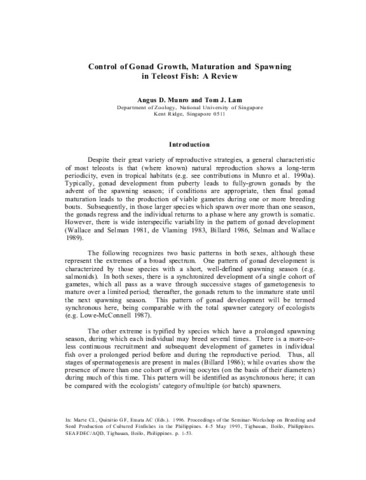Testicular histology and serum steroid hormone profiles in hatchery-bred catfish Clarias macrocephalus (Gunther) during an annual reproductive cycle

ရှာဖွေ/ဖွင့်ပါ။
ရက်စွဲ
1997Page views
379
Share
စိတ္တဇ
Testicular development, gonadosomatic index (GSI), and related steroid hormones (testosterone or T, 11-ketotestosterone or 11-KT, 17α, 20β-dihydroxy-4-pregnen-3-one or DHP) in serum were monitored during an annual reproductive cycle in tank-reared, hatchery-bred male catfish Clarias macrocephalus to established the season optimum for its artificial propagation. GSI values were highest in June (0.80%), and lowest in December, February, April (0.36%). At most times of the year, lobules in the testis and seminal vesicles were mostly lined with spermatogonia B (SGb) and spermatocytes (SC) and few spermatogonia A (SGa); spermatids (SD) and spermatozoa (SZ) were the least and most abundant of the spermatogenic cells, respectively. In January however, almost equal counts of SGa, SGb and SC were observed, as well as a significant increase in the percentage of SD and corresponding decrease in SZ. Serum 11-KT fluctuated at high levels, with the lowest level in January (159.42 ng/ml), and peak in September (434.72 ng / ml). Serum T levels ranged from 15-25 ng/ml, and were not markedly different throughout the annual cycle. Serum DHP levels were extremely low in January-May, and reached maximum levels in July (0.18 ng/ ml). Seasonal changes in the percentage of spermatogenic cells, GSI and serum steroid hormone profiles showed that captive, hatchery-bred male C. macrocephalus have a continuous reproductive cycle. Although milt release was not observed, males can readily be used as source of milt for artificial propagation at any time of the annual cycle, except in January.
Suggested Citation
Tan-Fermin, J. D., Miura, T., Ueda, H., Adachi, S., & Yamauchi, K. (1997). Testicular histology and serum steroid hormone profiles in hatchery-bred catfish Clarias macrocephalus (Gunther) during an annual reproductive cycle. Fisheries Science , 63(5), 681-686. http://hdl.handle.net/10862/1605
ဘာသာရပ်
စုစည်းမှုများ စုစည်းမှုများ
- AQD Journal Articles [1249]
Related items
Showing items related by title, author, creator and subject.
-
Control of gonad growth, maturation and spawning in teleost fish: A review
Munro, Angus D.; Lam, Tom J. (Aquaculture Department, Southeast Asian Fisheries Development Center, 1996)Despite their great variety of reproductive strategies, a general characteristic of most teleosts is that (where known) natural reproduction shows a long-term periodicity, even in tropical habitats (e.g. see contributions ... -
Effect of juvenile hormone and serotonin (5-HT) on mixis induction of the rotifer Brachionus plicatilis Muller
Gallardo, Wenresti G.; Hagiwara, Atsushi; Snell, Terry W. (Elsevier, 2000)Juvenile hormone (JH) and serotonin (5-HT) were previously shown to enhance mictic (sexual) female production of the rotifer Brachionus plicatilis in batch cultures. To explore the basis of these effects, experiments were ... -
Influence of LHRHa and methyltestosterone on milt production of sea bass Lates calcarifer (Bloch)
Hilomen-Garcia, G. V.; Baldevarona, R. B.; Lacanilao, F. J. (Aquaculture Department, Southeast Asian Fisheries Development Center, 1996)Milt volume, sperm density, and number of spermatozoa were determined to quantify milt production of mature sea bass after a single injection of LHRHa [(D-Ala6,Pro9-N-ethylamiide)LHRH] in saline solution and 17α-methyltestosterone ...



